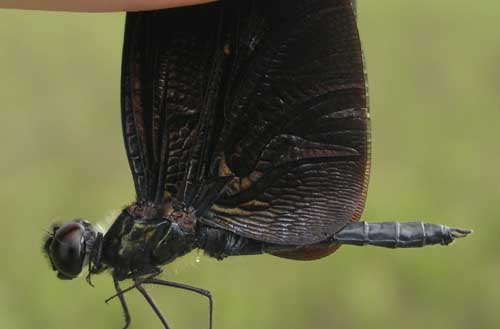
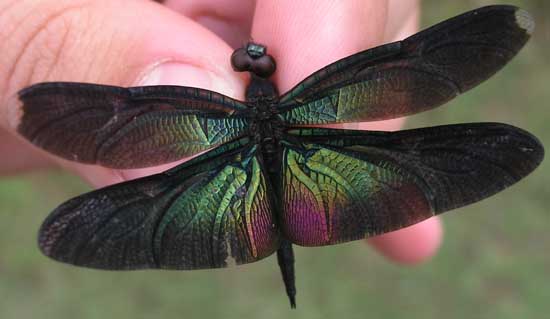
18 May
The first site is a pond. Itís a bit cloudy so the dragons are slow and I swipe a few big ones easily. There are about 10 common species flying about. Just another pond, I guess. Wait! Whatís this? Dragon about two inches long, clear wings, a black (or very dark blue) body with the first two sections of the abdomen bright yellow! Iíve never seen this one before. (I suspect it may be a wasp mimic, mostly because thatís the first thing I thought of when I saw it - Thatís a wasp mimic!). He keeps himself in an area just out of the optimal sweep of my net. Finally I take a shot, and miss. He flies away, never to be seen again. Oh well, he who fights and runs away, lives to fight another day. I continue around the pond collecting more and more as I go. Almost all the way around I see something I had completely forgotten about. There are two good books one Thai dragonflies. One is very technical with keys and drawings of specific parts of the anatomy. The other has ranges of each species, notes on each, and photographs of about one third of the dragons of Thailand. One the cover of the first (but not at all in the second) is a small poor picture of a dragonfly black wings that shimmer like oil on water in the sun light. The picture is not named in the book (as far as I know) and I often wondered if the animal actually existed. Twenty feet in front of me is just that Dragon.
Before we go on let me tell you something about dragonfly wings. They are not flat. Some veins stand above the level of the wing, and others below. This creates an air foil which allows the dragon to glide. A fly, on the other hand, canít glide, and must constantly beat its wings or it will fall. Some dragonflies (the genus Celithemis in Missouri and my White Whale over here) will beat their wings and then glide, beat and then glide. Wandering through the air like theyíre half awake. That is, until you take a swipe at them, then theyíre little bolts of lightening. They fire just 2 inches to the left or right or over the net, you miss and look like an idiot. Often they then slowly (but faster than you can run) fly off into the sunset, and you are left to cuss alone. We are dealing with just such a flyer.
I take a swipe and find this out. Iím sweating bullets. The only one Iíve seen, canít let it get away! Swipe one- Miss. Swipe two - Miss (but heís still here!). Third swipe - HIT! I (carefully!) get my pictures. This was a good site!


Head to the next site. Now, I must tell you why I am here. The quicker of you no doubt realized that it has something to do with dragonflies. Well, all dragonflies have an adult and an immature stage. The adults fly around and the immatures swim about. Immatures look like the exuviae that I show pictures of (in fact this is the final outer covering that an immature has). Now if you collect an adult dragonfly in Thailand there is a 95% chance that you can find out what species it is (there are some undescribed species still scooting about). If, however, you collect an immature dragonfly in Thailand there is only about a 1% chance that it can be identified to species. There must be an association between adult and larvae. This is easily done by rearing a dragonfly. Now you have and adult and exuviae (adult and larvae). My prime directive for this adventure is to make these associations. I have, throughout the trip, been collecting live dragonfly larvae and attempting to rear them. Sickness, failure, loss of limbs, arrests, and tragic elephant tramplings are all issues I would rather not mention (this is a happy log), therefore I have not mentioned my failure to rear any larvae.
We are on a single lane dirt road in middle of nowhere. All of a sudden we come to a brand new bridge (twice as wide as the road) which spans a beautiful stream. We dismount and begin collecting. I work my way up the stream and get all I can. I watch for exuviae left on the plants and rocks near the shore. Dragons in the tropics typically emerge at night, so they are ready to fly when the birds (perhaps the early bird) are out hunting. So finding a dragon while or just after it has emerged is a rare thing. Well, honestly, I got lucky. Its 1 in the afternoon. The sun is beating down, Iím dripping with sweat and I see a HUGE dragon hanging from a plant just inches from ground. Teneral! I carefully (but very quickly) drop my net over it and snake it out, carefully placing it in its own container. Now the fun starts. I have the adult, but can I find the skin he left when he emerged? On a leaf just inches from where he was hanging I find the exuvia. Ladies and Gentleman, we have an association! Just 314 more to go!
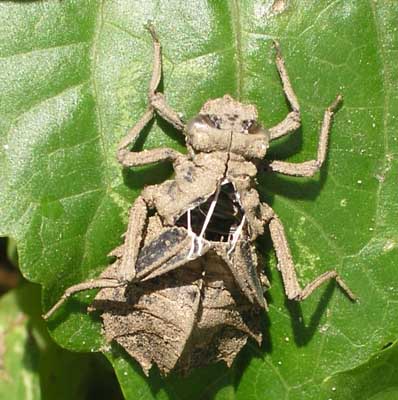
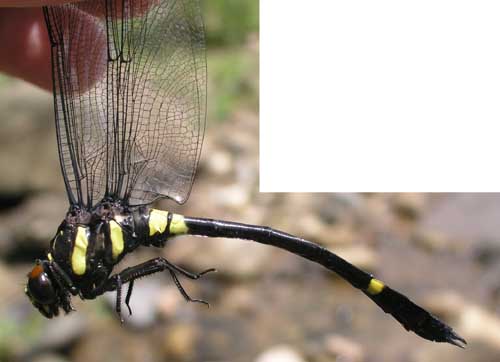
Thailand doesnít have ticks or chiggers, but they do have leaches, but terrestrial and aquatic. The great thing about leaches is that they donít vector any diseases to humans. The bad thing is you donít feel them till its too late, and after you pull them off you bleed like a stuck pig (they have an anticoagulant). This little guy was swimming along when I got his picture, heís about 6 inches long here.
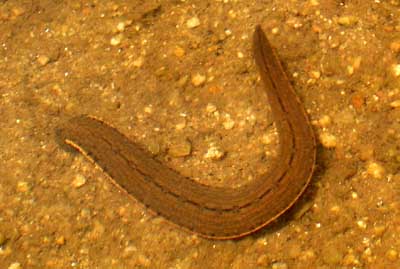
Iím not a very good birder so when this guy shot across the clearing I shot a general picture and hoped for the best. Fully zoomed in this is what I got.

After we got done collecting at this site we ate. I got a picture of the table and chairs at the shop beside us.

The next stream was just as beautiful. I got some plant pictures, the roots sweep with the flow of the water, and this is a fresh stalk of something.
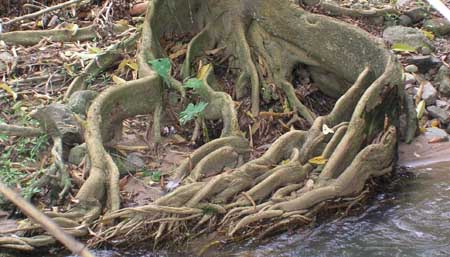
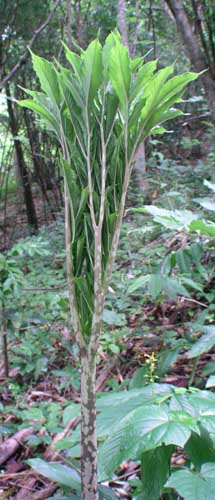
While weíre looking at plants let me show you the most unusual bark Iíve seen. The first plant ID class I took started in winter, so we learned to ID trees using bark, and limb characteristics, so Iím always looking at tree bark. It can be very distinct and quite impressive at times. It looks as if someone has taken a chisel to the entire tree. I have seen these at other places, but am now fairly convinced that this is natural.
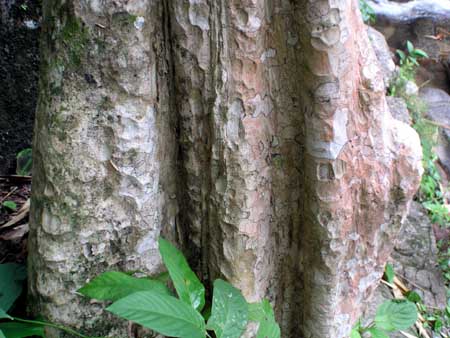
I collected a gomphid that may do new to my collection.
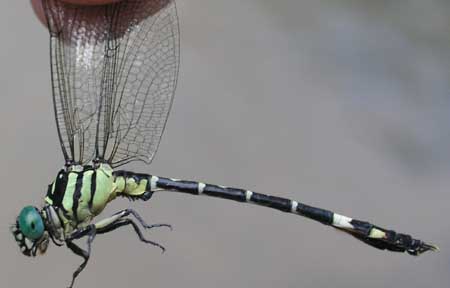
A photo of A collecting.
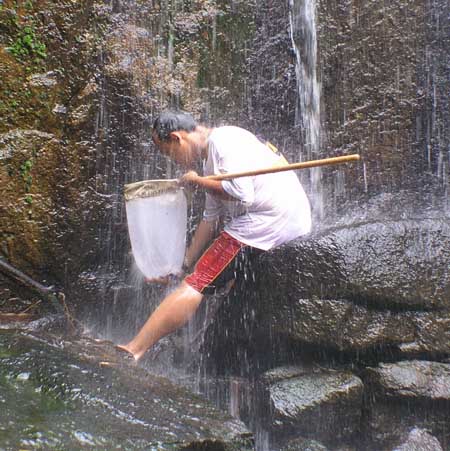
Last site for the day, home, eat, deal with specimens, write log, shower, and sleep.
19 May
First site is a stream, and offers a beautiful flower (about a foot tall) on the walk in.
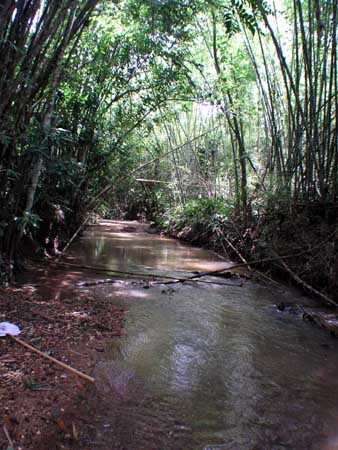
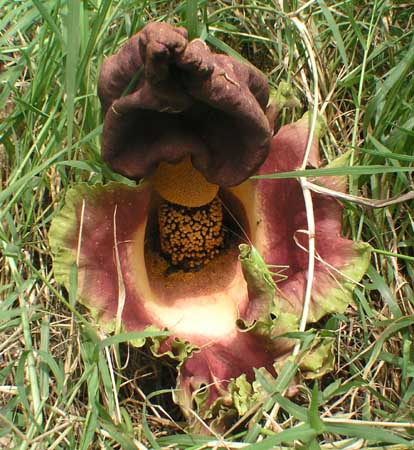
The second site is a triplet of ponds baking under the tropical sun. The usual suite of species are flying about. Remember that one I havenít got yet? Wasp Mimic, black body and yellow ring. Well, lots of misses, but I connected. Actually got two before we left!
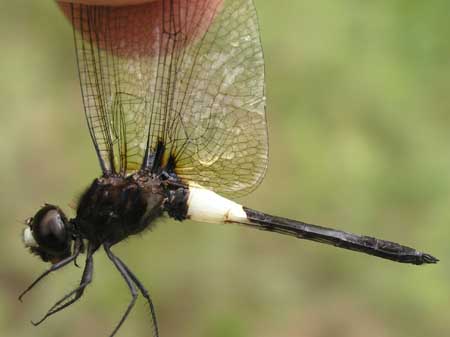
Iíve been collecting enough here that I know which species to expect at a particular site, and watch for them. On the far side of the middle pond, about 10 minutes after I collected the above, I see in the grass out of the corner of my eye and flit of yellow and brown. There is one species of dragon (a female) that is yellowish and about that big, but this was way too fat (thinks I). I spin my head around and search the brush with my good eye, and what do I pick up but another species of owlfly! Iím headed to Texas for a few weeks at the end of July to go to an international symposium about Neuroptera (the order to which owlflies belong) and perhaps I will be able to have these guys identified (or find a paper which I can use to ID them).
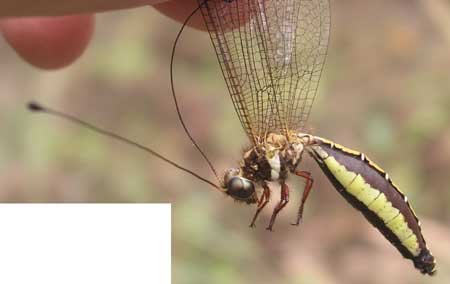
The next site is a small pond bordered on one side by an electric fence (Careful!).
The last site of the day is another pond. I get a new species for me. A distinct feature of this very small dragon is the brown tips of the wings, so I worked him around and got two kinds of pictures.
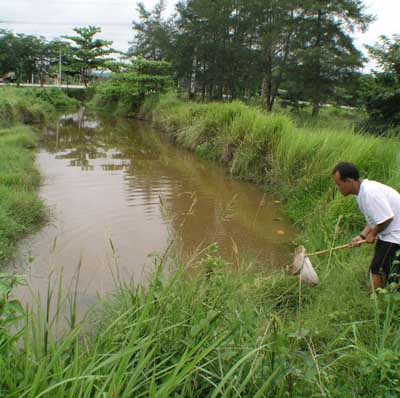
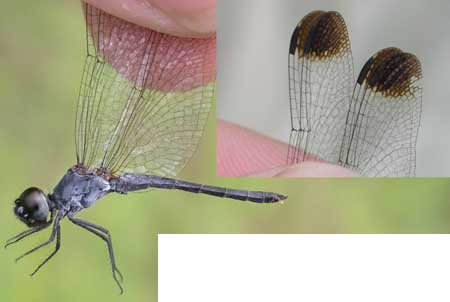
We decide to call it a day. Weíve been about two weeks of working without a break and a few extra hours are needed to write logs, take care of stuff and rest. Itís a new day tomorrow, and who knows what new stuff we may find.